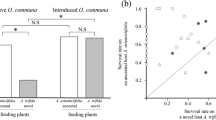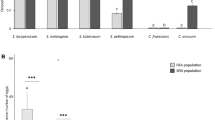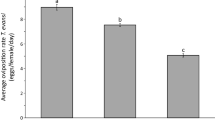Abstract
This study examined the host-selection ability of the broad mite Polyphagotarsonemus latus (Banks) (Acari: Tarsonemidae). To make long-distance-shifts from one host plant patch to another, broad mites largely depend on phoretic association with whiteflies. However, the host plants of whiteflies and broad mites are not necessarily the same. We determined the host-preference and acceptance of free-moving and phoretic broad mites using two behavioral bioassays. We used a choice test to monitor host selection by free-moving mites. In the case of phoretic mites, we compared their rate of detachment from the phoretic vector Bemisia tabaci placed on leaves taken from various host plants. The suitability of the plant was further determined by monitoring mite’s fecundity and its offspring development. We compared the mites’ responses to young and old cucumber (Cucumis sativus cv. ‘Kfir’) leaves (3rd and 8–9th leaf from the apex, respectively), and two tomato (Solanum lycopersicum cvs. ‘M82’ and ‘Moneymaker’). Free-moving mites of all stages and both sexes preferred young cucumber leaves to old cucumber leaves and preferred young cucumber rather than young tomato leaves, demonstrating for the first time that broad mites are able to choose their host actively. As for phoretic mated females, although eventually most of the mites abandoned the phoretic vector, the rate of detachment from the whitefly vector was host dependent and correlated with the mites’ fitness on the particular host. In general, host preference of phoretic female mites resembled that of the free-moving female. Cues used by mites for host selection remain to be explored.




Similar content being viewed by others
References
Agrawal AA (2000) Host-range evolution: adaptation and trade-offs in fitness of mites on alternative hosts. Ecology 81:500–508
Agrawal AA, Vala F, Sabelis MW (2002) Induction of preferente and performance alter acclimation to novel hosts in aphytophagous spider mite: Adaptive plasticity? Am Nat 159:553–565
Berlinger MJ (1986) Host plant resistance to Bemisia tabaci. Agri Ecosyst Environ 17:69–82
Bernays EA (1999) When host choice is a problem for a generalist herbivore: experiments with the whitefly, Bemisia tabaci. Ecol Entomol 24:260–267
Byrne DN, Bellows TS (1991) Whitefly biology. Annu Rev Entomol 36:431–458
Cross JV, Bassett P (1982) Damage to tomato and aubergine by broad mite, Polyphagotarsonemus latus (Banks). Plant Pathol 31:391–393
Fry JD (2003) Multilocus models of sympatric speciation: Bush versus Rice versus Felsensestein. Evolution 57:1735–1746
Gadd CH (1946) Observations on the yellow tea mite Hemitarsonemus latus (Banks) Ewing. Bull Entomol Res 37:157–162
Gerson U (1992) Biology and control of the broad mite, Polyphagotarsonemus latus (Banks) (Acai: Tarsonemidae). Exp Appl Acarol 13:163–178
Gotoh T, Bruin J, Sabelis MW, Menken SBJ (1993) Host race formation in Tetranychus urticae: genetic differentiation , host plant preference and mate choice in a tomato and cucumber strain. Entomol Exp Appl 68:171–178
Grinberg M, Perl-Treves R, Palevsky E, Shomer I, Soroker V (2005) Interaction between cucumber plants and the broad mite, Polyphagotarsonemus latus : from damage to defense gene expression. Entomol Exp Appl 115:134–144
Huang X, Renwick JAA (1993) Differential selection of host plants by two Pieris species: the role of oviposition stimulants and deterrents. Entomol Exp Appl 68:59–69
Krokos FD, Konstantopoulou AM, Mazomenos EB (2002) Chemical characterization of corn plant compounds by different extraction techniques and the role of potent chemicals in the reproductive behaviour of the corn stalk borer Sesamia nonagrioides. Use of pheromones and semiochemicals in integrated production. IOBC/WPRS Bulletin 25:1–9
Magalhães S, Forbes MR, Skoracka A, Osakabe M, Chevillon C, McCoy KD (2007) Host race formation in the Acari. Exp Appl Acarol 42:225–238
Mayhew PJ (1997) Adaptive patterns of host -plant selection by phytophagous insects. Oikos 79:417–428
Nomikou M, Janssen A, Sabelis MW (2003) Herbivore host plant selection: whitefly learns to avoid host plants that harbour predators of her offspring. Oecologia 136:484–488
Palevsky E, Soroker V, Weintraup P, Mansour F, Abo-Moch F, Gerson U (2001) How species-specific is the phoretic relationship between the broad mite, Polyphagotarsonemus latus (Banks) (Acai: Tarsonemidae), and its insect hosts? Exp Appl Acarol 25:217–224
Renwick JAA, Chew FS (1994) Oviposition behaviour in Lepidoptera. Annu Rev Entomol 39:377–400
Schoonhoven LM, Jermy T, van Loon JJA (1998) Insect-Plant Biology. From physiology to Evolution. Chapman and Hall, London
Skoracka A, Kuczynski L (2006) Is the cereal rust mite, Abacarus hystrix really a generalist?- Testing colonization performance on novel hosts. Exp Appl Acarol 38:1–13
Smith FF (1935) Control experiments on certain Tarsonemus mites on ornamentals. J Eco Entomol 28:91–98
Soroker V, Nelson RD, Bahar O, Reneh S, Yablonski S, Palevsky E (2003) Whitefly wax as a cue for phoresy in the broad mite, (Polyphagotarsonemus latus (Banks) (Acai: Tarsonemidae). Chemoecology 13:163–168
Thompson JN (1988) Evolutionary ecology of the relationship between oviposition preference and performance of offspring in phytophagous insects. Entomol Exp Appl 47:3–14
Yano S, Wakabayashi M, Takabayashi J, Takafuji A (1998) Factors determining the host plant range of the phytophagous mite, Tetranychus urticae (Acari: Tetranychidae): a method for quantifying host plant acceptance. Exp Appl Acarol 22:595–601
Zarate SI, Kempema LA, Walling LL (2007) Silverleaf whitefly induces salicylic acid defenses and suppresses effectual jasmonic acid defenses. Plant Physiol 143:866–875
Acknowledgments
We wish to thank Prof. Uri Gerson and Dr. Eric Palevsky for providing helpful discussion, Dr. Hillary Voet and Mrs. Miri Zarhi for help with statistic analysis. We also thank Mrs. Svetlana Kontsedalov for providing the Bemisia tabaci used in our studies, Mr. Saadia Reneh for plant cultivation and our three anonymous reviewers for helpful comments.
This manuscript is contribution no. 503/07 of the Institute of Plant Protection, Volcani Center, ARO, Israel.
Author information
Authors and Affiliations
Corresponding author
Rights and permissions
About this article
Cite this article
Alagarmalai, J., Grinberg, M., Perl-Treves, R. et al. Host Selection by the Herbivorous Mite Polyphagotarsonemus latus (Acari: Tarsonemidae). J Insect Behav 22, 375–387 (2009). https://doi.org/10.1007/s10905-009-9179-y
Revised:
Accepted:
Published:
Issue Date:
DOI: https://doi.org/10.1007/s10905-009-9179-y




